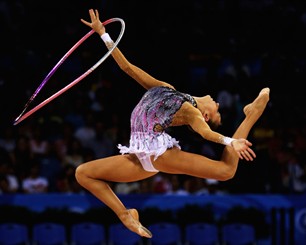Rhythmic Gymnastics
Updated: 2012-05-14 17:45
(london2012.com)
|
|||||||||||
Grace and beauty will be on show throughout the four days of Rhythmic Gymnastics competition at Wembley Arena.
Rhythmic Gymnastics first appeared during the 19th century and slowly grew in popularity until the first experimental competitions were staged during the 1930s.
Having evolved to incorporate elements from classical ballet, German muscle-building techniques and Swedish exercise systems, it's one of the most beautiful spectacles on the Olympic programme.

Competition dates
Aug 9 - 12
Competition venue
Wembley Arena
Two – Individual All-Around and Group All-Around (six gymnasts make up a group, but only five of them compete in each of the two routines)
Number of medal events
Number of competitors
96 – all women
Each country is limited to eight athletes (two Individual athletes and a group of six athletes for the Group event)
Field of play
Gymnasts compete on a floor measuring 13 metres x 13 metres.
History of Rhythmic Gymnastics at the Olympic Games
The first World Rhythmic Gymnastics Championships were held in Budapest in 1963, just over two decades before the discipline made its Olympic debut at the Los Angeles 1984 Games. A Group event was added to the programme at Atlanta 1996.
The basics
One of just two women-only disciplines in the Olympic Games (the other is Synchronised Swimming), Rhythmic Gymnastics is a combination of gymnastics and dance. Individual competitors perform short routines to music using hand apparatus – a hoop, a ball, clubs and a ribbon. Groups perform two routines, one with five balls and the other with three ribbons and two hoops. Scores are awarded in three categories: difficulty, artistry and execution.
During the routines the apparatus must be in constant motion, with a variety of moves performed.
Competition format
The Individual All-Around competition features two phases: the qualification round and the final. Each athlete performs with each apparatus in the qualification round, and the top 10 athletes advance to the final for one more routine with each apparatus. The gymnast with the highest total score in the final wins the event.
In the Group competition qualification round, the five gymnasts in a group perform with five balls for the first routine. Then, in the second routine, they perform using three ribbons and two hoops. The scores for these routines are added together. The top eight groups then progress to the final, where they compete again in two routines.
Officials
Three juries, each with four judges, calculate the final score. This is made up of difficulty, artistry and execution, with marks deducted for penalties.
Keys to success
Although it is incredibly graceful, gymnasts need great strength and control. Athletes are judged against a strict set of criteria depending on which apparatus they are using. The apparatus need very different techniques: ball (flexibilities and leaps), clubs (balances and pivots), ribbon (pivots and leaps), and hoop (flexibilities, leaps, pivots and balances). The winning athletes will come as near to perfection as possible with all four of the apparatus.
Breaking the rules
As well as being judged against an exacting set of criteria, where poor execution will lose points, athletes can also be penalised for a variety of infringements including the music being too long or short, crossing the boundaries of the floor, a knot appearing in the ribbon, gripping (rather than balancing) the ball, or the hoop vibrating in the air.
Jargon buster
Hoop – hoops may be made from wood or plastic, must have an inner diameter of 80–90cm and must weigh at least 300g.
Ball – made of rubber or soft plastic, the balls used in Rhythmic Gymnastics must have a diameter of 18–20cm and must weigh at least 400g.
Clubs – gymnasts work with two bottle-shaped clubs of equal length (40–50cm), each weighing at least 150g.
Ribbon – made from satin or a similar material, ribbons used in Rhythmic Gymnastics must be 7m long (the first metre is doubled over, so ribbons are effectively 6m long), and are attached to a short cane (50–60cm) made from wood, bamboo, fibreglass or plastic.
Performance area – gymnasts perform on a square competition area, measuring 13m by 13m.
Today's Top News
President Xi confident in recovery from quake
H7N9 update: 104 cases, 21 deaths
Telecom workers restore links
Coal mine blast kills 18 in Jilin
Intl scholarship puts China on the map
More bird flu patients discharged
Gold loses sheen, but still a safe bet
US 'turns blind eye to human rights'
Hot Topics
Lunar probe , China growth forecasts, Emission rules get tougher, China seen through 'colored lens', International board,
Editor's Picks

|

|

|

|

|

|





